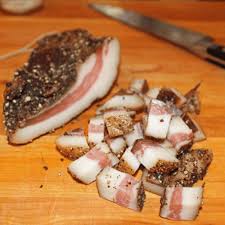
Guanciale: A Savory Italian Delight
Guanciale: A Savory Italian Delight Few ingredients in Italian cooking are as delicious and unique as Guanciale. This article will take you on a culinary adventure as it explains what Guanciale is, its long and storied history, its many culinary applications, and why it is becoming increasingly popular outside Italy.
Guanciale, you ask?
Traditional Italian cured pork jowl or cheek is called Guanciale. The term “guancia,” which means “cheek” in Italian, is where the name “guanciale” comes from. Despite their resemblance, Guanciale and bacon are two entirely different things.
Backstory and Development
The Lazio region of Italy is where Guanciale first emerged centuries ago. Particularly in traditional Roman cuisine, Guanciale has been used for decades. It was developed to keep pork fresh without access to refrigeration.
Pancetta vs. Guanciale
The two cured pork products, Guanciale and pancetta, are often mistaken for one another. They’re both Italian-cured meats, but their flavor profiles and textures couldn’t be more different. While both pancetta and Guanciale are prepared from pork, the sweetness comes from the cheek meat, giving it a deeper, more complex flavor than pancetta.
The Production of Guanciale
Preparing Guanciale takes a lot of time and effort. The pork jowl is cured with salt, black pepper, and other spices before being air-dried for a few weeks. Careful preparation like this makes Guanciale the delicious specialty it is.
Uses in the Kitchen: Guanciale
Guanciale is highly prized for its many culinary uses. Its exquisite flavor and versatility mean it may be used in various cuisines.
Classic Italian Dishes That Use Guanciale
Guanciale is a hero ingredient in many classic Italian dishes. One of the most well-known recipes is “Pasta alla Gricia,” a dish made with pasta, Guanciale, Pecorino Romano cheese, and black pepper.
Today’s Guanciale Dishes
Guanciale’s popularity has spread far beyond Italy, making it a prized component of cuisine worldwide. Both professional kitchens and household kitchens are finding exciting new uses for Guanciale.
Salami and Good Health
While Guanciale’s flavor is undeniable, it’s essential to consider the risks before eating it. Due to its high-fat content, moderation in its consumption is encouraged, especially for individuals watching their cholesterol levels.
Locating Guanciale
Recently, Guanciale has become easier to find when shopping outside Italy. This Italian delicacy is now available to a broader audience because of the widespread availability of the product at gourmet food stores and on the Internet.
Methods and Advice for the Kitchen
Knowing how to handle and cook Guanciale is essential to experiment with it in your kitchen. Here are some tricks for cooking with Guanciale that will impress your guests.
Common Recipes with Guanciale
From the classic “Spaghetti alla Carbonara” to the current “Guanciale-wrapped Scallops,” we’ll explore some popular dishes that emphasize Guanciale’s distinctive and delectable properties.
The use of Guanciale has increased in favor among chefs and foodies worldwide in recent years. Its rising popularity can be attributed to its unusual flavor and ability to elevate foods.
Conclusion
Italian cured beef guanciale is more than just a tasty treat. It’s a metaphor for continuity, deliciousness, and the ability to keep culinary heritage alive. Guanciale is a gastronomic treasure that should be included in the kitchen of any ambitious cook, whether professional or amateur.
Questions That Were Asked Often
where can you find Guanciale if you don’t live in Italy?
The widespread availability of Guanciale at gourmet markets and on the Internet has made it possible for its consumption worldwide.
When comparing Guanciale with pancetta, what are the key distinctions?
The pork jowl or cheek is used to make Guanciale, whereas the pork belly is used to make pancetta. The flavor of Guanciale is more profound and sweeter.
Is there any risk to my health if I eat Guanciale?
Because of its high-fat content, Guanciale should be consumed in moderation, especially by those trying to lower their cholesterol.
In what traditional Italian dishes does Guanciale typically appear?
“Pasta alla Gricia” and “Spaghetti alla Carbonara” significantly feature guanciale.
How can I use Guanciale in modern cuisine?
Pasta and appetizers are just two of the many food categories where Guanciale shines. Many dishes can benefit from its robust flavor Take advantage of the chance to add Guanciale to your culinary repertoire. Use this Italian gem in your kitchen to unlock new flavor profiles and craft one-of-a-kind meals. Enjoy your meal!

Guanciale: A Savory Italian Delight

